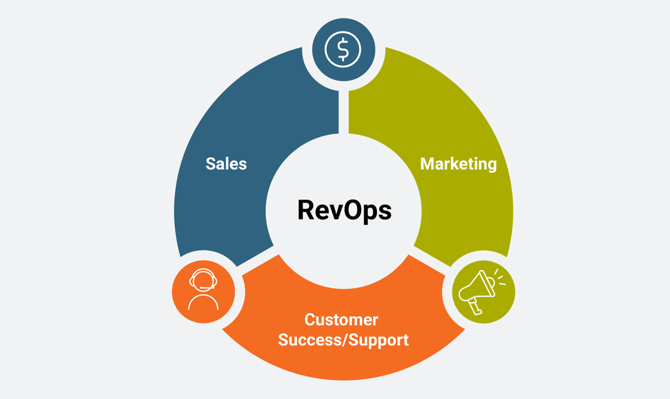RevOps Implementation Guide for Success
Revenue Operations (RevOps) is a holistic approach to aligning sales, marketing, and customer service departments within a company to drive growth through operational efficiency and revenue generation. Discover how to successfully implement RevOps strategies and boost your company's revenue growth.
Understanding RevOps and its Impact
RevOps, short for Revenue Operations, is a strategic approach that aligns sales, marketing, and customer success teams to drive revenue growth. It involves breaking down silos and fostering collaboration among these departments to create a cohesive revenue-generating machine.
By implementing RevOps strategies, companies can streamline their processes, improve communication, and optimize customer experiences. This leads to increased efficiency, higher customer satisfaction, and ultimately, a boost in revenue.
One important aspect of understanding RevOps is recognizing its impact on the entire customer lifecycle. From lead generation to customer retention, RevOps ensures that every touchpoint is optimized to drive revenue and create long-term value for the business.
Creating a RevOps Framework
To successfully implement RevOps, it is crucial to create a solid framework that aligns sales, marketing, and customer success teams towards a common goal. This framework should outline the roles, responsibilities, and processes of each department, as well as establish clear communication channels and metrics for success.
Key components of a RevOps framework:
- Defining the buyer persona journey and creating a seamless handoff between teams
- Implementing a shared tech stack that allows for data integration and analysis
- Establishing regular cross-functional meetings and collaboration sessions
- Setting up a feedback loop to continuously improve processes and strategies
By creating a RevOps framework, companies can ensure that all teams are working together towards revenue growth and are aligned on the key objectives and metrics.
Integrating Sales, Marketing, and Customer Success
Successful RevOps implementation requires seamless integration of sales, marketing, and customer success efforts. By breaking down departmental silos and fostering collaboration, companies can create a unified revenue-generating machine.

Integrating sales, marketing, and customer success:
- Aligning messaging and targeting across departments to create a consistent customer experience
- Sharing customer data and insights to improve lead generation and customer retention
- Collaborating on campaigns and initiatives to maximize impact and reach
- Implementing shared metrics and goals to ensure alignment and accountability
By integrating these departments, companies can leverage their collective expertise and resources to drive revenue growth and create a seamless customer journey.
Leveraging Technology for RevOps Success
Technology plays a crucial role in the success of RevOps implementation. By leveraging the right tools and platforms, companies can automate processes, gain actionable insights, and optimize their revenue operations.
Key technologies for RevOps success:
- Customer Relationship Management (CRM) systems for managing customer data and tracking interactions
- Marketing automation tools for lead generation, nurturing, and scoring
- Sales enablement platforms for content management, training, and analytics
- Business intelligence and analytics tools for data analysis and reporting
By adopting and integrating these technologies, companies can streamline their operations, improve decision-making, and drive revenue growth.

Measuring and Optimizing RevOps Performance
Measuring and optimizing RevOps performance is essential for continuous improvement and achieving revenue goals. By tracking and analyzing key metrics, companies can identify areas for improvement, make data-driven decisions, and optimize their revenue operations.
Key metrics for measuring and optimizing RevOps performance:
- Revenue growth and profitability
- Customer acquisition cost (CAC) and customer lifetime value (CLTV)
- Sales cycle length and conversion rates
- Marketing ROI and lead-to-opportunity conversion rates
- Customer satisfaction and retention rates
By regularly monitoring these metrics and conducting performance reviews, companies can identify bottlenecks, implement targeted improvements, and drive continuous revenue growth.
Case Studies of successful RevOps implementation
#1: A Technology SaaS Company valued at $200 million
Background: A mid-sized Software as a Service (SaaS) company was facing challenges with siloed departments, inconsistent data management, and inefficient lead handling processes. The lack of coordination between sales, marketing, and customer support teams was leading to missed opportunities and a disjointed customer experience.
RevOps Implementation: The company implemented a RevOps strategy that involved integrating their Customer Relationship Management (CRM) systems, marketing automation tools, and customer support platforms. This integration allowed for a seamless flow of information across teams. They also established a centralized data management system to ensure data accuracy and accessibility.
Results: The implementation led to a 40% increase in sales productivity due to better lead qualification and prioritization. Marketing campaigns became more targeted and effective, resulting in a 25% increase in lead conversion rates. The customer support team was able to provide more personalized and timely support, enhancing customer satisfaction and retention rates. Overall, the company saw a 30% increase in annual revenue within the first year of RevOps implementation.

#2: A Global E-Commerce Retailer featured on the NYSM Exchange
Background: A large e-commerce retailer was struggling with inconsistent customer experiences across different regions and inefficient cross-departmental workflows. Their growth was being hampered by outdated processes and a lack of real-time data sharing between teams.
RevOps Implementation: The retailer embarked on a RevOps journey by adopting a unified platform for their e-commerce operations, customer service, and marketing efforts. They implemented advanced analytics and business intelligence tools to gain real-time insights into customer behavior and market trends. A key part of their strategy was also the development of a cross-functional team dedicated to optimizing the customer journey from discovery to post-purchase support.
Results: The RevOps strategy led to a significant improvement in operational efficiency, with a 50% reduction in time spent on manual processes. The retailer was able to offer a more cohesive and personalized shopping experience, resulting in a 35% increase in customer lifetime value. Additionally, the company achieved a 20% year-over-year revenue growth, attributed to more effective marketing strategies and improved sales processes.
These case studies demonstrate the transformative potential of RevOps when implemented effectively. By breaking down silos, leveraging technology, and focusing on data-driven decision-making, companies across different industries can achieve substantial growth and operational efficiency.
Want to learn more? Please share your issues to discuss your RevOps strategy directions.
Hello, refer to the CRM marketing guidelines for achieving revenue growth.

Share this
You May Also Like
These Related Stories

Sustainable Growth Strategies: NRR and Sustainable Revenue in SaaS

HubSpot Acquires Clearbit: Revolutionizing Sales Prospecting


No Comments Yet
Let us know what you think